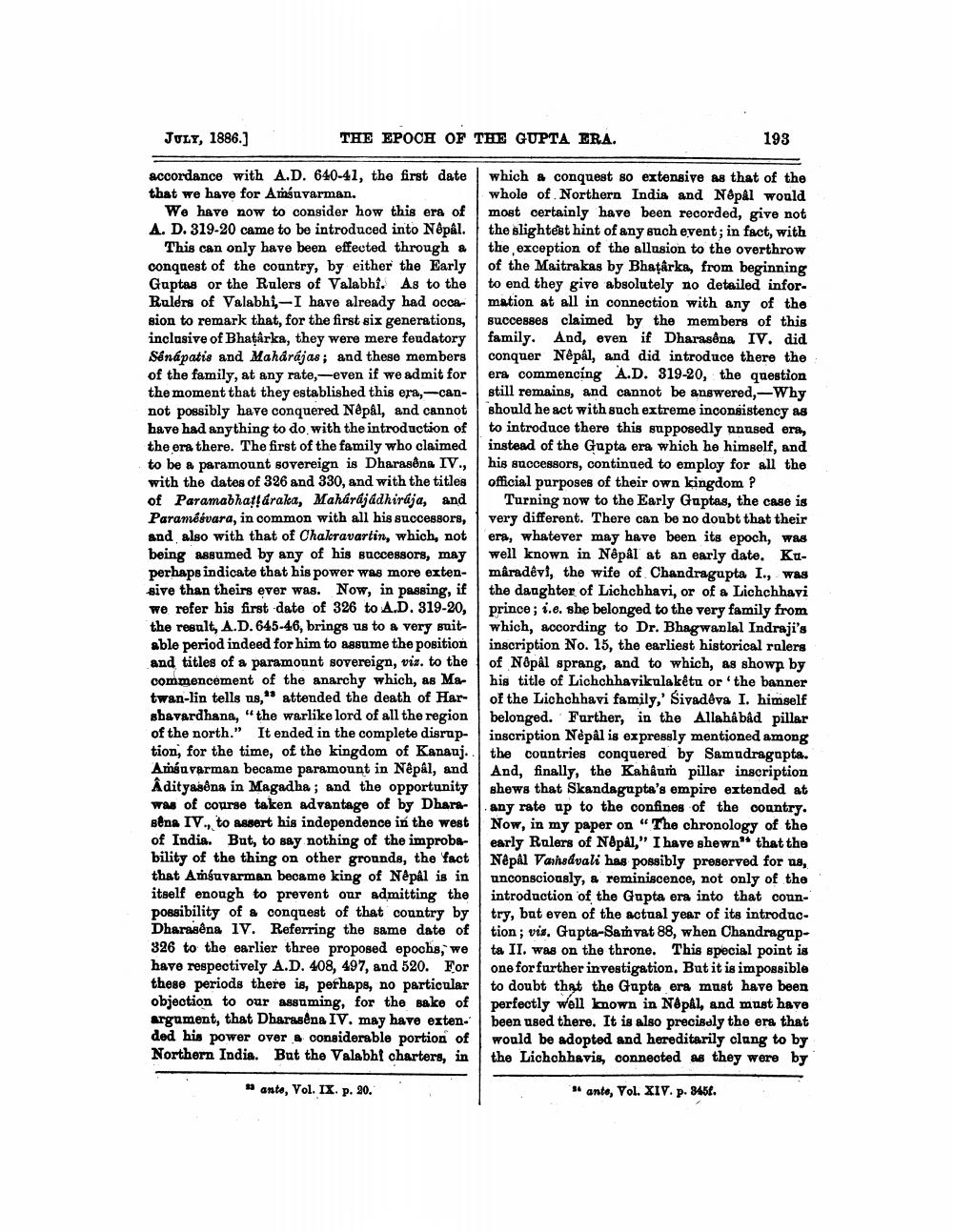________________
JULY, 1886.]
THE EPOCH OF THE GUPTA ERA.
193
accordance with A.D. 640-41, the first date which & conquest so extensive as that of the that we have for Arsuvarman.
whole of Northern India and Nepal would We have now to consider how this era of most certainly have been recorded, give not A. D. 319-20 came to be introduced into Nepal. the slightest hint of any such event; in fact, with
This can only have been effected through a the exception of the allusion to the overthrow conquest of the country, by either the Early of the Maitrakas by Bhatarka, from beginning Guptas or the Rulers of Valabhi. As to the to end they give absolutely no detailed inforRulers of Valabhi-I have already had occa mation at all in connection with any of the sion to remark that, for the first six generations, successes claimed by the members of this inclusive of Bhatarka, they were mere feudatory family. And, even if Dharasêna IV. did Sánápatis and Maharajas; and these members conquer Népal, and did introduce there the of the family, at any rate,-even if we admit for era commencing A.D. 319-20, the question the moment that they established this era, -can- still remains, and cannot be answered, -Why not possibly have conquered Nepal, and cannot should he act with such extreme inconsistency as have had anything to do with the introduction of to introduce there this supposedly unused era, the ora there. The first of the family who claimed instead of the Gupta era which he himself, and to be a paramount sovereign is Dharasóns IV., his successors, continued to employ for all the with the dates of 326 and 330, and with the titles official purposes of their own kingdom ? of Paramabhatáraka, Maharajadhiraja, and Turning now to the Early Guptas, the case is Paramésvara, in common with all his successors, 1 very different. There can be no doubt that their and also with that of Chalcravartin, which, not era, whatever may have been its epoch, was being assumed by any of his successors, may well known in Nepal at an early date. Kuperhaps indicate that his power was more exten- maradevi, the wife of Chandragupta I., was sive than theirs ever was. Now, in passing, if the daughter of Lichchbavi, or of a Lichchhavi we refer his first date of 326 to A.D. 319-20, prince; 1.e. she belonged to the very family from the result, A.D. 645.46, brings us to a very suit- which, according to Dr. Bhagwanlal Indraji's able period indeed for him to assume the position inscription No. 15, the earliest historical rulers and titles of a paramount sovereign, viz. to the of Népal sprang, and to which, as shown by commencement of the anarchy which, as Ma- his title of Lichchhavikulakëtu or the banner twan-lin tells us," attended the death of Har- of the Lichchhavi family,' Sivadova I. himself sbavardhana, "the warlike lord of all the region belonged. Further, in the Allahâbâd pillar of the north." It ended in the complete disrap- inscription Népal is expressly mentioned among tion, for the time, of the kingdom of Kananj. the countries conquered by Samudragupta. Amía varman became paramount in Népal, and And, finally, the Kahkum pillar inscription Adityasona in Magadha; and the opportunity shews that Skandagapta's empire extended at was of course taken advantage of by Dhara- any rate up to the confines of the country. sēns IV., to assert his independence in the west Now, in my paper on “The chronology of the of India. But, to say nothing of the improba- early Rulers of Nepal," I have shewn" that the bility of the thing on other grounds, the fact Nepal Varnsdvali has possibly preserved for us, that ATMsuvarman became king of Nepal is in unconsciously, a reminiscence, not only of the itself enough to prevent our admitting the introduction of the Gupta era into that connpossibility of a conquest of that country by try, but even of the actual year of its introducDharagêna IV. Referring the same date of tion; vis. Gupta-Samvat 88, when Chandragap826 to the earlier three proposed epochs, we ta II. was on the throne. This special point is have respectively A.D. 408, 497, and 520. For one for further investigation. But it is impossible these periods there is, perhaps, no particular to doubt that the Gupta era must have been objection to our assuming, for the sake of perfectly well known in Nepal, and must have argument, that Dharagêna IV. may have exten.' been used there. It is also precisely the era that ded his power over a considerable portion of would be adopted and hereditarily clang to by Northern India. But the Valabht charters, in the Lichchhavis, connected as they were by
anto, Vol. IX. p. 20.
* ante, Vol. XIV. p. 845€.




